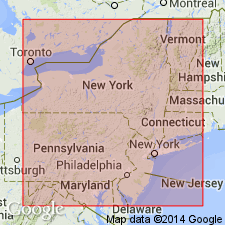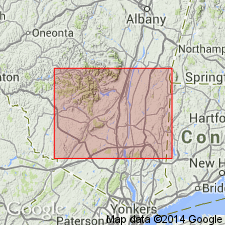
- Usage in publication:
-
- Alsen cherty limestone
- Modifications:
-
- Named
- Dominant lithology:
-
- Limestone
- Chert
- AAPG geologic province:
-
- Appalachian basin
Summary:
Name Alsen cherty limestone proposed for 20 to 50+ feet of cherty limestones that overlie the Becraft and contain a modified Becraft fauna. Shown in hills above Alsen, at Becraft, and Schoharie. Everywhere stratigraphically continuous with the Becraft. Heretofore classed as Port Ewen, but near Port Ewen Station, the Port Ewen beds rest disconformably on the Alsen.
Source: GNU records (USGS DDS-6; Reston GNULEX).

- Usage in publication:
-
- Alsen Formation
- Modifications:
-
- Areal extent
- Overview
- AAPG geologic province:
-
- Appalachian basin
Summary:
Alsen Formation of Helderberg Group, 6.1 m thick at Kingston, NY, thins to 0.6 m at Wallpack Center, NJ. Underlies Lake Katrine Member (new) of Port Ewen Formation or unconformably underlies Oriskany Sandstone of Tristates Group. Overlies New Scotland Formation of Helderberg Group. Age is Early Devonian. Report includes measured section.
Source: GNU records (USGS DDS-6; Reston GNULEX).
For more information, please contact Nancy Stamm, Geologic Names Committee Secretary.
Asterisk (*) indicates published by U.S. Geological Survey authors.
"No current usage" (†) implies that a name has been abandoned or has fallen into disuse. Former usage and, if known, replacement name given in parentheses ( ).
Slash (/) indicates name conflicts with nomenclatural guidelines (CSN, 1933; ACSN, 1961, 1970; NACSN, 1983, 2005, 2021). May be explained within brackets ([ ]).

